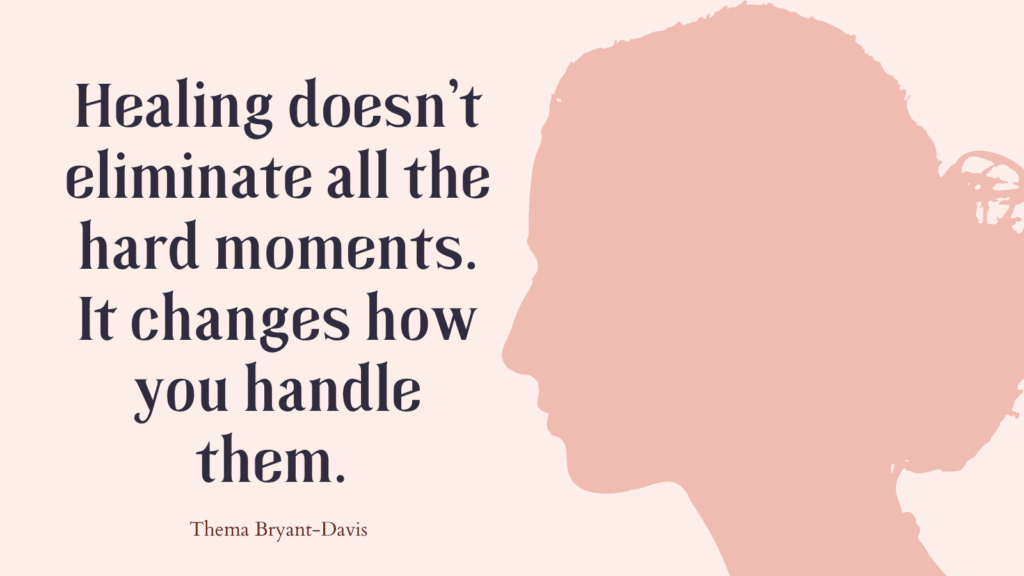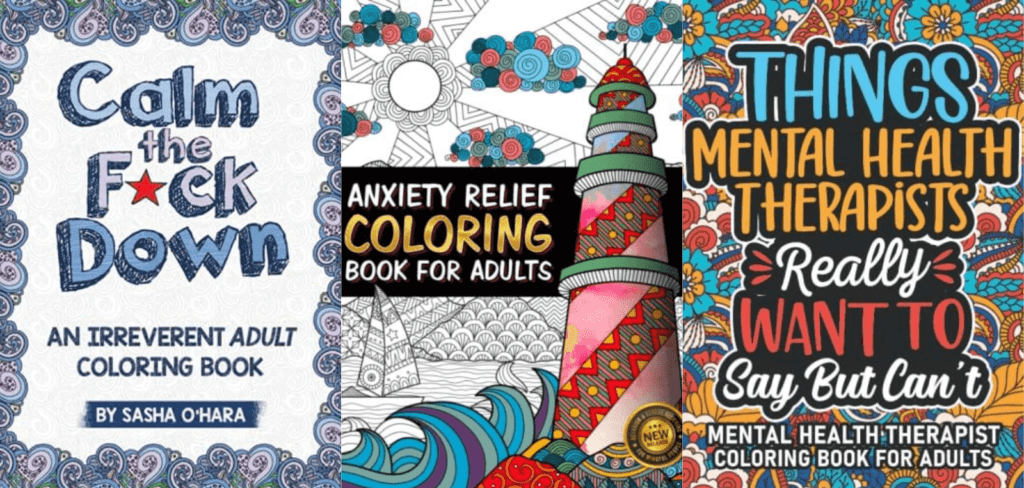Today, you’re going to learn how to practice trauma informed mindfulness meditation safely when you have PTSD.
It is estimated that 90% of the population has been exposed to a traumatic event and that 8-20% of these people will develop posttraumatic stress disorder, or PTSD.
Trauma is an extreme form of stress that can overwhelm our ability to cope.
And while trauma creates stress, mindfulness reduces it. This is why mindfulness can be the antidote to trauma.
Theoretically, anyone, including trauma survivors can benefit from practicing mindfulness.
However, for people who’ve experienced trauma, mindfulness can trigger symptoms of traumatic stress and even lead to retraumatization.
These symptoms include heightened emotional arousal, flashbacks, and dissociation.
This is where trauma-sensitive mindfulness comes.
By using mindfulness in a way that doesn’t exacerbate symptoms of traumatic stress, trauma survivors can benefit from mindfulness and safely connect with their inner state again.
Traumatic Stress
Traumatic stress results from being exposed to one or a series of traumatic events. These include intimate and domestic violence, date rape, sexual assault, violence from racism, etc.
The exposure can result from directly experiencing or witnessing a traumatic event, or learning that the event occurred to a family member or close friend. It can also result through repeated exposure to the details of the trauma, including in the context of one’s work, such as in the case of first responders and emergency care physicians.
Sings of traumatic stress include ongoing flashbacks, volatile emotional reactions that emerge without warning, intense physical sensations mainly in the form of anxiety and panic attacks.
Traumatic stress can be a spectrum from stress, to traumatic and posttraumatic stress, to PTSD. This is why people can suffer from traumatic stress without meeting the criteria for a diagnosis of PTSD.
Related: Why Is Trauma Therapy So Hard? (+Best Trauma Healing Exercises To Support Your Recovery)
Can Mindfulness Trigger Trauma?
Mindfulness might appear to be a safe and innocuous practice. But for trauma survivors, it can exacerbate symptoms of traumatic stress if not done in a trauma-sensitive way.
Exteroceptive And Interoceptive Sensations
There are two types of sensations each individual has: exteroceptive and interoceptive sensations.
Exteroceptive sensations are nerves related to the five senses of touch, taste, smell, sight, and hearing – they help us relate to what is happening outside of our body.
Interoceptive sensations, on the other hand, are nerves that relate to what is happening for us internally. Our guts, for instance, provide us with immense amounts of interoceptive information that influence our entire organism, which explains the terms gut feeling or gut instinct.
When our exteroceptive and interoceptive sensations are integrated, we become able to maneuver through the world and make effective decisions about our behavior. We might see a friend and have an uneasy feeling in our stomach, which prompts us to check in with them about their day.
For people who’ve experienced trauma, intero- and exteroceptors can become disintegrated. Even after a few years from the traumatic event, interoceptors continue signaling danger, while exteroceptors don’t detect any source of threat. This can create confusion and distress.
When practicing mindfulness, people who have experienced trauma will have to pay an inordinate amount of attention to interoceptive sensations. And when your inner world is constantly communicating threats, focusing on your interoceptive sensations can exacerbate your trauma symptoms.
Related: Best 6 Mindfulness Exercises For Beginners (+FREE Resources)
PTSD Mindfulness Exercises: How To Practice Trauma Informed Mindfulness Meditation (Safely)?
Trauma-sensitive mindfulness can help people find stability when faced with traumatic symptoms.
Mindfulness can enhance present-moment awareness, increase our self-compassion, and enhance our ability to self-regulate.
The question thus becomes: how can we use mindfulness to support our healing in a safe way?
Related: Best 8 Mindfulness Exercises For Adults That Will Help You Regulate Your Emotions
Step #1. Develop Dual Awareness
After a traumatic event, your interoceptors will continue signaling danger, even when exteroceptors can’t detect any source of real threat.
Focusing your attention on the internal state of your body, when practicing mindfulness, can overwhelm you and even re-traumatize you.
This is why you need to develop dual awareness when practicing mindfulness.
Using dual awareness, you can maintain multiple perspectives at the same time and balance awareness between your internal and external reality.
In practice, this means bringing your focus back to your surrounding (exteroceptors) to create a sense of safety.
Step #2. Stay Within the Window of Tolerance
The window of tolerance—a term coined by Dan Siegel, is an internal zone of support that helps trauma survivors feel stable, present, and regulated.
When you feel triggered or out of control, this is when you’re no longer in your safe zone – your window of tolerance.
1. Signals That You’re Outside Of You Window Of Tolerance
- Muscle tone extremely slack (collapsed) or rigid
- Hyperventilation
- A racing heart
- Excessive sweating
- Blurred vision
- Dissociation (feeling disconnected from your body or numb)
- Flashbacks, or intrusive thoughts
- Intense emotions of anxiety and hypervigilance
2. Ways To Apply The Brakes
Once you start feeling like you’re no longer inside your window of tolerance, use the following ways to regain control and regulate your emotions:
- Open your eyes during mindfulness practice.
- Take structured breaks from mindfulness practice (e.g., walking, stretching).
- Take a few slow, deep breaths.
- Soothe yourself through self-touch (e.g., put your hand on your heart).
- Focus on an external object in your environment (e.g., the view outside).
Related: Best 99 Coping Skills (+FREE Coping Worksheets)
Step #3. Establish Stable Anchors Of Attention
To support your window of tolerance, you need to learn how to shift your focus away from traumatic stimuli during mindfulness practice.
This can be done by opening your eyes and paying attention to the surrounding environment (e.g., the view outside the window, or an object in the room)
Shifting your attention can also be done by choosing a stable anchor of attention.
It’s important to choose an anchor that is stabilizing for you. Some people connect the breath, for instance, to trauma. It’s an area of the body that can hold tension related to trauma.
Instead of concentrating on the breath, you can choose anchors of attention that are more stabilizing for you, such as the feeling of your feet on the ground, or the sensations of your hands resting on your thighs.
Other stabilizing anchors might include another sense, such as hearing or sight. However, working with a sense that’s less tactile can be distracting and make it harder to bring your attention back to your practice.
Related: What Is the 333 Rule for Anxiety? (& Other Anxiety Coping Strategies)
Step #4. Increase Your resilience
Resilience involves deliberately turning your attention toward what brings you energy and joy. Recalling people or things we love is an example of resilience. So are self-care practices and connections with other people.
Using resilience in trauma-sensitive practice involves a brief intervention during mindfulness practice to imagine a place or a memory that connects us to a sense of well-being and safety.
Practicing resilience also helps maintain a wide window of tolerance.

Mindfulness Techniques For PTSD And Trauma
Formal Practice
1. Take a few moments to be still and enter the world of being rather than doing.
2. Begin this exercise by focusing on your breath and feeling into your body and mind and simply allowing any thought, emotion, or physical sensation to just be.
3. You don’t need to judge, analyze, or figure things out. Spend about three minutes simply checking in with yourself.
Informal practice means bringing mindful awareness to daily activities, such as doing chores, eating, exercising, relating to others, and any other action, whether at work, at home, or anywhere else.
Informal Practice
1. Choose a task that you normally do on a daily basis, like brushing your teeth or taking a shower.
2. Try to focus your attention on the task, bringing all of your senses to the experience.
3. If you’re taking a shower, feel and listen to the water pouring against your skin, and smell the shampoo you’re using, and visualize details you don’t usually notice, such as the iridescence of the bubbles.

Resources
- Portions of this article were adapted from the book Trauma‑Sensitive Mindfulness, © 2018 by David A. Treleaven. All rights reserved.
- Trauma and shock (apa.org)
- Emotional and Psychological Trauma – HelpGuide.org
- What is trauma? Types, symptoms, and treatments (medicalnewstoday.com)
- Understanding the Impact of Trauma – Trauma-Informed Care in Behavioral Health Services – NCBI Bookshelf (nih.gov)
- Trauma | Psychology Today
- Treating PTSD: A Review of Evidence-Based Psychotherapy Interventions – PMC (nih.gov)
- Treatments for PTSD (apa.org)
- Unlocking PTSD: New study reveals why trauma-focused psychotherapy treatment works — ScienceDaily



